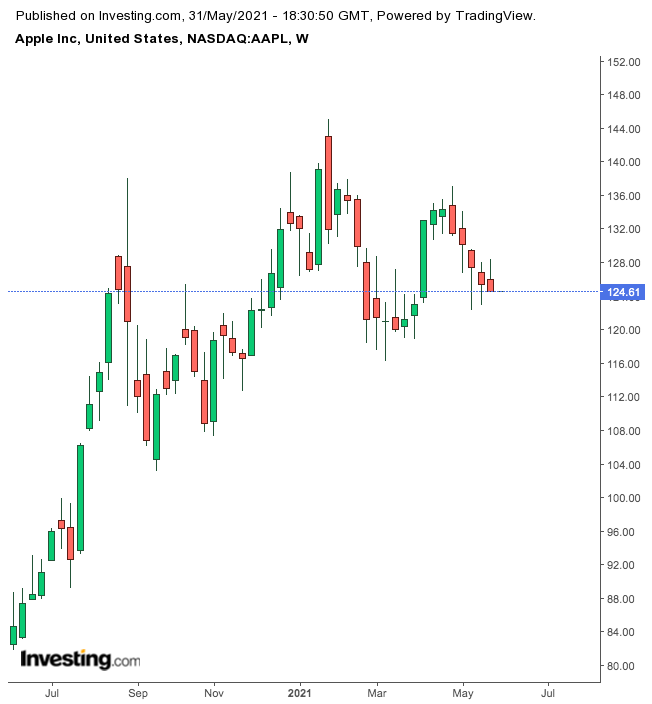Shares of Apple (NASDAQ:AAPL) have been under pressure ever since reaching a record in January. This persistent bearish spell is casting doubts in the minds of investors about the company’s growth potential in the post-pandemic world.
Apple hit an all-time high on Jan. 26, reaching $144.30 per share. On Friday, it closed at $124.61, down about 16%. During the same period, the benchmark NASDAQ Index remained almost unchanged.

After a drop of this magnitude, the temptation for a buy-on-the-dip trade is hard for some investors to resist, especially when this strategy has paid off repeatedly in the past for this particular stock. Apple shares have gained about 400% during the past five years, almost double the return delivered by the NASDAQ index.
Despite the iPhone maker’s excellent track record of rewarding long-term investors, some analysts are warning that Apple shares have a tough road ahead as the pandemic-driven boom of buying the latest hardware cools.
As employees return to physical offices after the accelerating vaccine drive in the developed world, the work-from-home demand for Apple’s hardware—including iPads and Mac computers—may also decline. In addition, the semiconductor industry’s rising chip shortages could become a bigger problem for the company’s future production volumes.
Material Downside Risk
According to New Street Research, Apple won’t be able to sustain strong sales for its flagship iPhone 12 in the current fiscal year. The confluence of events that made the iPhone 12 a success means that demand has been pulled forward, creating a risk for a disappointing follow-up in the company’s 2022 fiscal year, New Street said.
“We see material downside risk—shipments in the 180-200-million range vs. consensus at 234 million, and downgrade in the stock to sell.”
As well, New Street lowered its price target for Apple to $90 per share, which is 28% below where the stock closed on Friday.
This extremely bearish outlook, however, is not what the majority of Wall Street analysts are seeing for the remaining part of the year. Of 38 analysts covering the stock, 31 have a buy rating with the 12-month price target of $159.60.
Apple bulls continue to believe that the company’s iPhone sales will remain strong as more and more customers upgrade to 5G-enabled handsets.
JPMorgan analyst Samik Chatterjee said in his recent note that the 5G iPhone cycle is not only spurring strong consumer upgrades and switches, it's also positioning Apple for a higher share of the overall smartphone market.
Chatterjee, while raising its price target to $165 from $150 and reiterating its overweight rating, said:
"We raise our revenue and earnings estimates for FY21 on the strength, but more importantly raise our out-year iPhone, Mac, iPad and Services revenue expectations as well, as we expect Apple to continue to build on the strength with stronger replacement cycle-led demand and greater Services opportunity on a larger installed base.”
For the quarter that ended Mar. 31, however, Apple's money-making machine didn’t show any sign of slowing down. Chief Executive Tim Cook believes there is still room for iPhone growth with the newly introduced 5G cellular version of the device that’s in its early growth days.
The company reported a record $89.6 billion in sales for the quarter, up 54% from a year earlier. Overall, iPhone revenue for the March quarter rose 65% to $47.9 billion against the 42% gain that analysts had predicted.
Bottom Line
Apple stock is certainly losing some of its shine after a powerful rally during the pandemic. This weakness shows investors are closely watching to see whether historic, pandemic-induced business success can continue.
This wait-and-see approach may keep Apple’s stock under pressure this year unless the company yet again smashes analysts’ growth forecasts.
Which stock should you buy in your very next trade?
With valuations skyrocketing in 2024, many investors are uneasy putting more money into stocks. Unsure where to invest next? Get access to our proven portfolios and discover high-potential opportunities.
In 2024 alone, ProPicks AI identified 2 stocks that surged over 150%, 4 additional stocks that leaped over 30%, and 3 more that climbed over 25%. That's an impressive track record.
With portfolios tailored for Dow stocks, S&P stocks, Tech stocks, and Mid Cap stocks, you can explore various wealth-building strategies.
